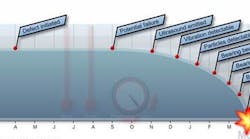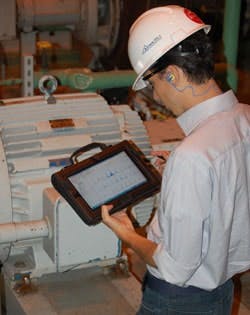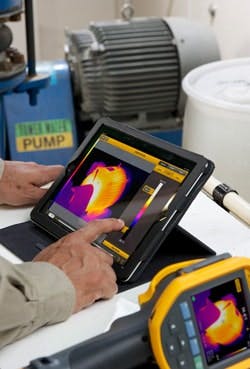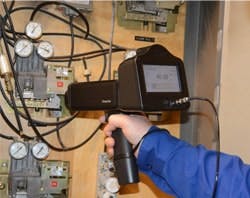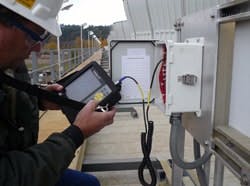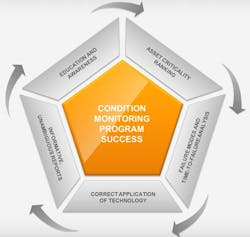Transitioning from reactive or run-to-failure maintenance modes to more efficient, predictive maintenance (PdM) necessitates often hard fought strategic investments. Fortunately, lower condition monitoring technology costs and affordable implementation alternatives are taking the edge off of this debate and encouraging more rapid and widespread adoption.
PS Cover Story - Jump to:
P1 Which assets benefit most from PdM?
P2 Making the most of your budget
P3 How to make technology choices
P4 Internal or outsourced resources?
P5 Analyze, communicate, & act
P6 Your return on PdM investment
PdM is a proven, proactive approach to preventing failures, eliminating machinery defects, and improving reliability while minimizing unproductive maintenance and costs. Successfully implementing a PdM program requires balancing budgets, goals, and existing resources against business priorities and technical requirements.
When 11 industry professionals were asked to share their advice on navigating this course, there was one recurring theme: “It depends.” The valuable counsel offered by these reliability consultants, educators, service providers, and technology vendors provides a strong starting point for choosing where to focus limited PdM dollars, who can best perform the tasks, how to use the data properly, and what new trends are boosting PdM success.
Which assets benefit most from PdM?
Consider the following when determining PdM priorities:
- What are the most costly shutdowns that could happen?
- What equipment would most likely cause this type of shutdown?
- What are the most likely points of failure for these types of equipment?
On the question of asset prioritization, there was no disagreement: PdM efforts should be focused on vital assets that pose the greatest risk of failure.
“Criticality of the assets to the production output and safety of the facility should play a big part in the initial PdM application,” suggests Shon Isenhour, a partner at Eruditio.
“A criticality analysis ranks the assets based on the risk they present to your company in the areas of safety, health, environment, business impact, quality, and other factors,” explains Bill Barto, director of the Reliability Solutions Group at Life Cycle Engineering (LCE). “For example, I would target a pump whose failure causes an immediate process disruption (high business impact) over a pump that has a backup on standby (low business impact).”
Jason Tranter, founder of Mobius Institute, takes that concept further. “Without an understanding of the failures modes, including an appreciation of the P-F interval (the time from first symptom to functional failure), it is not possible to determine which PdM technology can detect the fault or how frequently tests must be performed,” says Tranter.
“We look for low hanging fruit as well as the top 40 list of worst actors–the most expensive to maintain and least reliable–because if you don’t get early successes, the program will lose favor when the novelty wears off,” advises Timothy Dunton, director, instructor, and developer of Reliable Manufacturing at Reliability Solutions Training.
“Apply PdM to the top 20 percent of the critical equipment list first, and after the health of those assets improves, tackle the next 20 percent, and so on until more than 85 percent of your assets are covered,” suggests Andy Page, principal consultant for the Technical Services Group at Allied Reliability Group.
{pb}
Making the most of your budget
[sidebar id="3"]
PdM funding commitments may initially be difficult to win, so choose an approach that delivers substantive wins in order to justify continuing investments.
“Businesses tend to make emotional decisions regarding how to manage PdM,” says Reliability Solutions’ Dunton. “If they have a failure that they blame on a lack of vibration analysis, they might start doing vibration analysis on everything. But if there is a limited budget, it is more important to do PdM correctly, which requires good decisions.”
“Let asset criticality and your predominant failure modes be your guide,” recommends Eruditio’s Isenhour. “Map the technologies to your failure modes, and then determine which technologies will identify the largest number of critical failure modes and provide the greatest value as compared to their acquisition and training costs.”
He encourages leveraging existing investments. “If you already have vibration technologies available at your site, you would target critical rotating assets. If you already have ultrasonic equipment, you might focus on compressed air leaks and ultrasonic lubrication,” explains Isenhour.
“I would start with the PdM technology that everyone already possesses: their human senses,” says LCE’s Barto. “Begin with simple visual and audible indicators of how well your equipment is running, and resist the temptation to run out and buy other equipment before getting used to the idea of basic condition monitoring.
“A good example is a client that had many air conditioning filters that were replaced after a certain number of days. I recommended a device that used the differential pressure across the filter to ‘whistle’ when it became dirty. Now, they listen for the whistle and replace the filter only when it is sufficiently dirty,” explains Barto.
{pb}
How should technology choices be made?
[sidebar id="3"]
New technology investments should be based on three criteria, according to Allied Reliability Group’s Page:
- Effectiveness of the PdM technology across all asset types
- Ease of implementation (e.g., learning the hardware, software, and technique)
- Degree of reception by those in the organization
“Infrared thermography covers all asset types, is relatively easy to learn, is much cheaper than vibration analysis, and it’s very easy for people to accept the information coming from the camera as the truth,” says Page. “The same can be said for passive ultrasound, but it is not the case for vibration analysis.”
“No single technology is better than the other,” remarks Tyler Evans, business unit manager of vibration and alignment products at Fluke Corporation. “A plant with lots of motors may want to focus on vibration and thermography. One with many gearboxes and drive shafts might benefit more from oil analysis and thermography. A plant with a lot of automation and electrical control systems may lean toward thermography and power quality tools.”
“Thermography offers great amounts of detail in reasonably short periods of time without physical contact with the equipment," explains Michael Stuart, senior manager of thermography services at Fluke. "Vibration analysis enables earlier detection and diagnoses problems, although it requires direct contact with the equipment. Motor testing is one of the most common forms of reactive testing, but it can be incorporated into a more proactive program.”
“Regular, periodic vibration testing and analysis has been shown to be the most broadly applicable PdM technology, providing the best bang for the buck compared to other technologies,” suggests Joe Van Dyke, VP of operations at Azima DLI.
“Ultrasound can offer one of the fastest ROI’s of any of the PdM technologies,” says Doug Waetjen, VP of global operations at UE Systems. “It can be used on such a diverse number of assets and failure modes for compressed air leaks, electrical inspection of energized assets, bearing testing and trending, and condition-based lubrication. Ultrasound also has one of the shortest learning curves.”
One successful approach noted by Waetjen is to use ultrasound to conduct an audit of your compressed air system, document the hard-dollar savings from the audit, and use the savings to fund more in-depth analysis of your assets, such as RCM Blitz and failure mode and effects analysis (FMEA).
“Each condition monitoring technology is able to detect certain types of faults, whether it’s bearing failure, electrical hot spots, or lubricant contamination, and some technologies provide earlier warnings than others,” explains Mobius Institute’s Tranter. “For example, vibration analysis and oil analysis should be performed on gearboxes, but don’t rely on thermography for an early warning.”
Tranter believes an organization must also assess its own maturity. “Should they start with the more simple technologies such as ultrasound, infrared, or overall-level meters or bearing meters, or dive in with sophisticated vibration analysis equipment?”
The training effort is an important consideration. “Some condition monitoring technologies can be deployed relatively quickly with minimal expense and training. Other technologies require a significant investment, not only in equipment hardware, but in training before people can start becoming proficient,” remarks Dave Leach, condition monitoring and vibration specialist at LUDECA, Inc.
{pb}
Internal or outsourced resources?
[sidebar id="3"]
The personnel and partners involved in PdM can make or break the program, so be sure to weigh all your options when delegating the tasks.
“If the plant culture is one of ‘we take care of things ourselves,’ then internal resources are the best. If the culture is one of ‘we find the experts and trust them to do it for us,’ then outsourcing is the best,” says Allied Reliability Group’s Page. “There is no technological advantage that outweighs the cultural advantage of matching your solution to your environment.”
PdM programs are dynamic. Reevaluate your approach if:
- Your analyst leaves or retires
- You need to expand your program
- Your program funding is cut
- You need new measurement/analysis tools
- Your corporation wants consistency at all sites
The decision often comes down to finances. “A careful comparison of the costs involved with in-house resources (procurement, calibration, storage, training, certification, etc.) and outsourced resources is necessary for each of the different technologies,” says LCE’s Barto. “In my experience, ultrasound and thermography are fairly intuitive, training can usually be done with the equipment supplier, and results can be gathered almost immediately. Vibration, tribology, and motor testing are more advanced and typically demand much more training.”
Reliability Solutions’ Dunton suggests looking internally first. “My personal opinion is to always leverage inside help. For a few thousand dollars you can start a vibration program with no bells and whistles, which means even a small plant can do it themselves,” explains Dunton. “If you choose outside help, use it to get started but have an exit plan to take over the program internally.”
“A hybrid model with both internal and external resources has proven to be very effective,” suggests Eruditio’s Isenhour. “The key is to aggregate all the PdM data on all assets from the external and internal sources into one place, so that the site can truly understand its asset health and risks of failure.”
Azima DLI’s Van Dyke also sees value in the hybrid approach. “Running a vibration program in house requires trained technicians to collect the data, highly trained analysts to qualify the results, capital expense for the equipment, and occasional upgrade or service and support fees. Outsourcing vibration analysis and renting the data collection equipment provides a cost effective means for ensuring state-of-the-art instrumentation and consistent analytical results, enabling the best return on investment possible,” explains Van Dyke.
Whether the work is performed internally or outsourced, maintaining the right knowledge set is essential. “The availability of expertise is the single factor that determines the success and sustainability of a PdM program,” adds Ken Piety, VP of technology at Azima DLI.
{pb}
Analyze, communicate, & act
[sidebar id="3"]
Collecting and analyzing the data is only the first step. PdM is at its best when it drives meaningful action.
“The most important use of PdM data is the creation of follow-up work,” says LCE’s Barto. “Guess how many failures will be avoided if you utilize all known forms of PdM technology and check for failures constantly, but never take any actions based on the findings. Zero!”
“We are becoming a nation of data collectors; we are no longer thinking like analysts,” remarks Reliability Solutions’ Dunton. “PdM tools need to be used in a proactive way to troubleshoot the root of the problem in order to actually improve the machine – not just fix it when it’s failing.”
Proactive use of the data also ensures early and accurate diagnoses. “Detecting faults with very little time to failure is almost the same as doing nothing – it is still reactive maintenance, which is dangerous and expensive,” cautions Mobius Institute’s Tranter.
“If the tools are used properly and the data is interpreted correctly, your PdM program will provide time to plan and schedule the repairs at the lowest total cost, including downtime costs,” says Eruditio’s Isenhour. “Train your PdM technicians effectively and keep their skills fresh or you will be left with a program that provides a false sense of security due to poor interpretation of the data.”
“Consistent readings must be compared to appropriate standards or baselines and trended over time,” adds Azima DLI’s Van Dyke. “Failure to do so can lead to false alarms or false negatives that seriously undermine a program’s credibility.”
“Bi-weekly, weekly, or at least monthly intervals are needed to distinguish normal conditions from special variations,” says Fluke’s Evans. ”Make the data accessible and viewable; not hidden on a spreadsheet or someone’s hard drive. Put it on a network or cloud and make it available to many. Visual dashboards are great for helping all stakeholders quickly understand a condition.”
LUDECA’s Leach agrees with the importance of intuitive communications. “The real trick is to deliver the asset health information to the right people at the right time, in a manner that can be easily understood by everyone concerned,” says Leach. “Adopting a failure severity ranking system (green = good, yellow = slight, orange = moderate, red = critical) goes a long way because it’s easier for everyone to understand.”
Effective data reporting ensures lasting executive support. “Reporting and documenting the results of any PdM inspection is paramount to getting and maintaining support of a program,” says UE Systems’ Waetjen. “Selling the program and its importance to the organization must be an ongoing process.”
Azima DLI’s Piety agrees. “Today’s PdM program must involve and inform stakeholders in different departments and at different locations so they can be aware of what is known and what actions are being taken or not,” says Piety.
{pb}
Your return on PdM investment
[sidebar id="3"]
New options in technology, processes, analytics, and communications are accelerating the return on PdM investments.
“Above all else, lower cost instrumentation has really changed the industry,” says Reliability Solutions’ Dunton. “You can get an IR camera now for $1,000 that five years ago cost $50,000. PdM used to involve an elite few, but with the lower costs, the floodgates are open.”
The tools are smarter and simple enough for anyone to use, and the technology is applied more often. “In a recent class of mechanics, we sent 15 guys to go look for air leaks, and within 15 minutes they found $7,500 worth with an easy-to-use ultrasound gun. We see this also with IR guns and patch or viscosity tests on oil,” explains Dunton.
“Everyone is carrying a smartphone or tablet, and wireless networks are now more stable and pervasive. You can easily communicate what you’re seeing, ask what others think, and send data or dashboards for input,” adds Fluke’s Stuart. “I expect we will see more companies combining permanently affixed sensor data with portable test and measurement data to get the complete picture.”
Eruditio’s Isenhour believes the most exciting emerging trend has to do with combining of the data from all of the PdM technologies and existing process instrumentation into one master database. “Once captured together, using algorithms that look at interrelationships, we can see and better understand the causes of defects much earlier,” he says.
LCE also commented on the process intelligence trend. “It expands the typical equipment that can be analyzed through traditional PdM technologies into anything that can be measured,” explains Barto. “Imagine what could happen if a piece of equipment in either a remote or hard-to-reach location alerts someone that its motor is running slower than expected and the fluid being pumped is not enough to meet production targets?”
“Remote diagnostics are really picking up,” says Allied Reliability Group’s Page. “Sites are finding that using their own people to collect the data gets them involved and engaged, while having an outside firm to provide the analysis and reporting enables the site to leverage the experts as well.”
“The internet and cloud-based PdM solutions are becoming valuable tools to deliver not only asset health information, but process information as well,” remarks LUDECA's Leach. “The data can be accessed from almost anywhere and configured so that only those with the proper access can see or manipulate the information.”
Fluke is seeing layers of measurement being applied to improve PdM efficiency. “A sophisticated vibration analysis might take an hour per asset, while a $2,000 vibration health screening meter takes just seconds per asset. Prescreening all assets with an entry-level device saves the sophisticated diagnostics for assets that really need it. The same holds true for thermography,” says Fluke’s Evans.
“We are seeing more shielding and guarding being placed around assets that could pose a danger to personnel,” says UE Systems’ Waetjen. “This is great for safety but not so great when those assets are on PdM testing routes, because many of these assets are going untested. Remote sensing options, both wired and wireless, allow the PdM inspections to be performed without a technician being in harm’s way.”
While the new opportunities and trends are hard to ignore, communicating the value of PdM plant-wide is an enduring theme. As Mobius Institute’s Tranter explains, “If everyone within an organization focuses on condition improvement or defect elimination, then without a doubt, maintenance and operational costs will be reduced and plant availability will be improved.”
